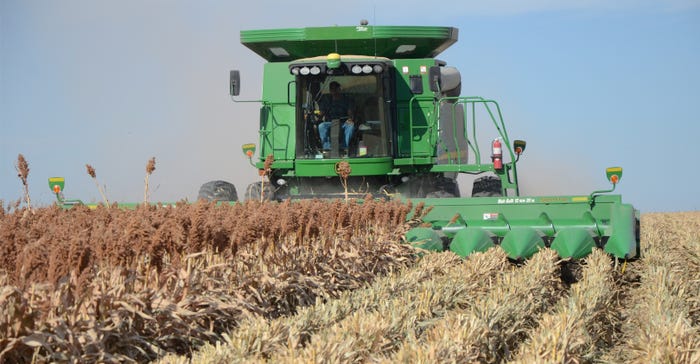
Last year, Mike Baker's irrigated sorghum yields broke 202 bushels per acre, setting a personal, as well as a state record. This year, however, it's his dryland sorghum acres that he's excited about.
During a year like this, when some parts of southwest Nebraska receive 5 or more inches above the annual average, sorghum may not seem like the most ideal crop to take advantage of the extra moisture. However, as growers like Baker have seen, this has been a great year for grain sorghum.
"This year, we had some of the best dryland yields we've ever had. It's been pretty ideal this year," says Baker, who grows sorghum on his farm near Trenton in southwest Nebraska.
Several hybrids under irrigation pushed 198 bushels per acre on his seed plots — likely due to less heat units compared to last year. Meanwhile, a few hybrids on his dryland acres broke 150.
"Mother Nature goes a long way; that's 80% of the battle," he says. "Usually, our limiting factor is rain, but this year, it was fertilizer."
Baker's nitrogen plan is fairly straightforward: apply 115 pounds of nitrogen up front based on soil tests and an expected dryland yield of about 120 bushels per acre. If additional nitrogen is needed, it's usually in the form of a slow release 28-0-0 at about 1 or 2 gallons per acre.
"You never anticipate getting the rainfall we got this year. It's a good problem to have, but in terms of nitrogen, it's good to a have a strategy to work around it," Baker says.
For the most part, sorghum is a dynamic crop. Baker typically plants a medium- to early-season maturity hybrid, which ensures he can harvest it all in a timely manner and avoid sorghum growing in cool fall nights in southwest Nebraska. Over the years, Baker has dropped dryland populations back from 75,000 to 50,000 plants per acre.
"I started looking at university recommendations and research on populations from years prior. It's also trial and error. You can have a huge reduction in population and really don't lose much in yield. Where I'm at now, it still could be reduced and not really affect yield," Baker says. "In 2017, I planted 15,000 plants per acre dryland, and it yielded 100 bushels per acre. Sorghum tillers so well that if conditions are optimal, it puts on multiple heads per plant. It gives you a little leeway in dry years when it doesn't rain."
Weed control can be a challenge for sorghum growers, especially in a place where weeds like kochia have developed resistance to different modes of action.
Baker's herbicide program includes a burndown of Verdict (a premix of saflufenacil and dimethenamid-P) with a methylated seed oil (MSO) adjuvant or Visor ATZ (metolachlor and atrazine) and glyphosphate, which is normally the only pass of a sprayer. If there are any broadleaf problems after sorghum emergence, an application of Huskie (pyrasulfotole and bromoxynil) takes care of it.
However, wheat stubble plays a big role in weed control, in addition to moisture retention. Baker's rotation includes winter wheat-sorghum-corn — with a fallow year in between corn and wheat. He harvests wheat with a Shelbourne stripper header, which leaves 36 inches of stubble in the field.
Research by USDA's Agricultural Research Service in Colorado has shown with 18 inches of wheat stubble height compared to 10 inches, about 1 to 3 additional inches of water are retained in the soil.
"You leave wheat stubble 3 feet tall and have 70- to 80-bushel wheat, it's a whole other form of weed control in itself," Baker says. "It shades the ground, catches the snow when it blows across. That's another reason I like grain sorghum. We had 8 inches of snow in early November, and my milo stubble caught all the snow. Nothing blew off. I'm going into a full profile. Next year I'll plant some corn into my milo stubble, and I guarantee there's a full profile of moisture out there."
Despite 2018 being a fairly wet year, that additional residue and water-holding capacity can help add extra bushels. This year, while individual sorghum hybrids in Baker's yield plots yielded as much as 135 to 150 bushels per acre, some fields averaged 145 bushels per acre.
"If I can average 145 bushels per acre on a full quarter, I'm pretty happy," Baker says. "2017 was probably the best year we've ever had in terms of dryland yields, and 2018 surpassed it by another 5 to 10 bushels per acre."
About the Author(s)
You May Also Like






